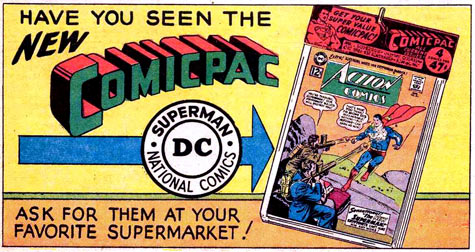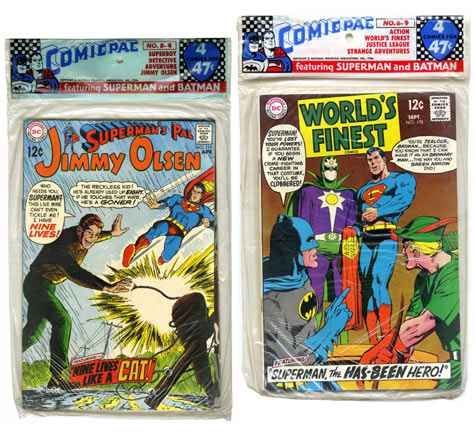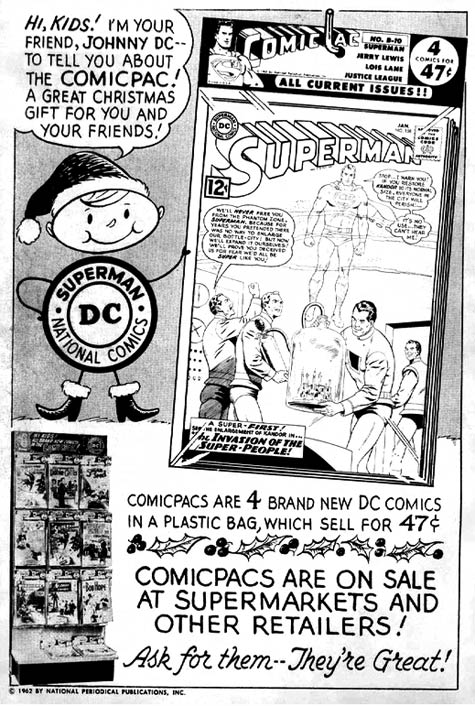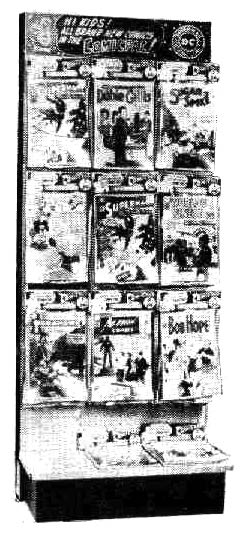| I recently came across this 1962 ad announcing
DC's "Comicpac," a collection of four comics sold
together in a plastic bag designed to be hung from a peg.
I'm not much of a comics historian, but I'm guessing the idea
was to market this format to stores that wouldn't have had
a magazine stand or spindle rack to sell them the usual way.

Apparently the format caught on, as I distinctly remember
these sorts of packages showing up in grocery stores, five-and-dimes
and even hardware stores well into the 70s, and maybe later.
By then, the strategy was usually to position the most popular
books to face the outside of the bag (meaning one of them
would have to be turned "backwards" to the other
three), with the two in the middle (and thus unseen) often
being the "booby prizes," titles you otherwise might
never have messed with.
In real life, the original 60s-era Comicpacs looked like
this:

Here's another early ad giving a glimpse at a display rack
designed specifically for the Comicpacs:

Here's an enlarged view of the rack for a (slightly) better
peek at the "banner" on top:

Normally four comics of this period would have cost you 48
cents, so at a "discount" of 47 cents it's not like
the Comicpac represented a huge savings (especially if you
didn't intend to buy all four titles anyway), but hey, there
was such a thing as penny candy back then, so if
your folks gave you two quarters you were in business.
By the 70s I seem to recall the Comicpac was a bigger bargain
than buying four comics individually at newsstand price, but
the drawback was that they usually were at least a couple
months out of date. By then, the labels were printed directly
on the bag itself, but with these early specimens, it seems
the labels were cards or stickers stapled or glued to the
top of the bag.
The labels are time capsules of comics history in themselves;
for instance the first design, in 1962, features the ubiquitous
Wayne Boring "arms akimbo" Superman
pose seen so often in merchandising of the era and, in the
example below, hints at the variety in the DC line of the
day, with Sea Devils and Dobie Gillis on
equal footing with the superheroes.

Jump ahead three years to 1965 and the Boring image remains,
but now surrounded by DC's infamous Silver Age "Go-Go
Chex." Superman's supremacy is still secure: In the bag
itself, Batman and Flash comics
are included, but only Superman rates a spot on the label,
despite his appearing in only one of the comics included,
and even then only as a supporting player to Jimmy Olsen.

Alas, what a difference a year makes; come 1966, Superman's
undisputed reign as DC's number 1 icon is suddenly over, as
he's forced not only to share the spotlight with Batman,
but to actually stand behind the Caped Crusader in
this, the seminal year of TV Batmania. Also, Wayne Boring's
"Superman Artist Supreme" status has been usurped
by Curt Swan.

By the end of the same year, Superman's reversal of fortune
is complete, as he's crowded off the label completely in favor
of Batman. In fact, by this point, the Caped Crimefighter
is such a hot commodity that the name of the product itself
has changed from "Comicpac" to "Batpac."
Holy Hostile Takeover!

The really cool thing about all of these labels
is that they tell you what's in the bag. That wasn't the case
with the generically labeled comic packs of the 70s. I can
still remember scrutinizing a bag of Marvels, tugging at the
(quite loose) packaging in an effort to pull forward a copy
of Avengers #145 and see what kind of lemon Marvel
was trying to sneak in behind it. The groupings always seemed
so arbitrary, I invisioned the bags being stuffed by half-sleeping
slave laborers in a sweatshop somewhere based on whatever
titles the publisher had the most leftovers of, and I fully
expected to one day find two copies of the same book in a
bag.
Along with the oversized tabloids, the tiny digests and the
100-page Super-Spectaculars, the Comicpacs always intrigued
me as experiments in the comic book packaging format. Of course
they'd never sell today, as collectors are too obsessed with
condition to pay money for four comics when two of them can't
even be seen. No, now we'd rather have the books out in the
open, where we can inspect the spine and corners and flip
through the pages to make sure none stick together or have
creases. We want our comics pristine.
You know, so we can go home and put them in a bag.
Update: Here's more on the history
of Comicpacs at the cool "Thought Baloon" website.
|








